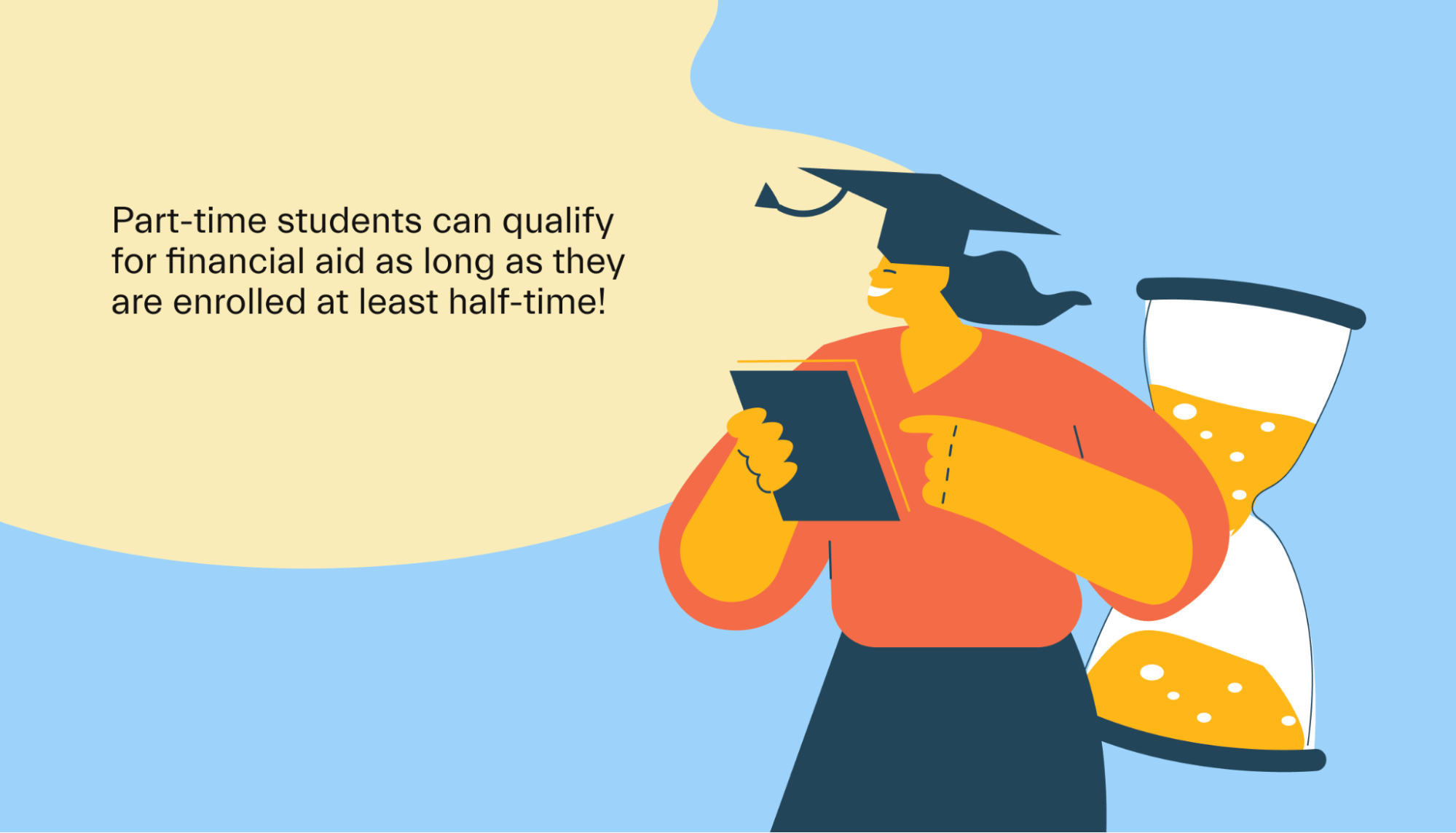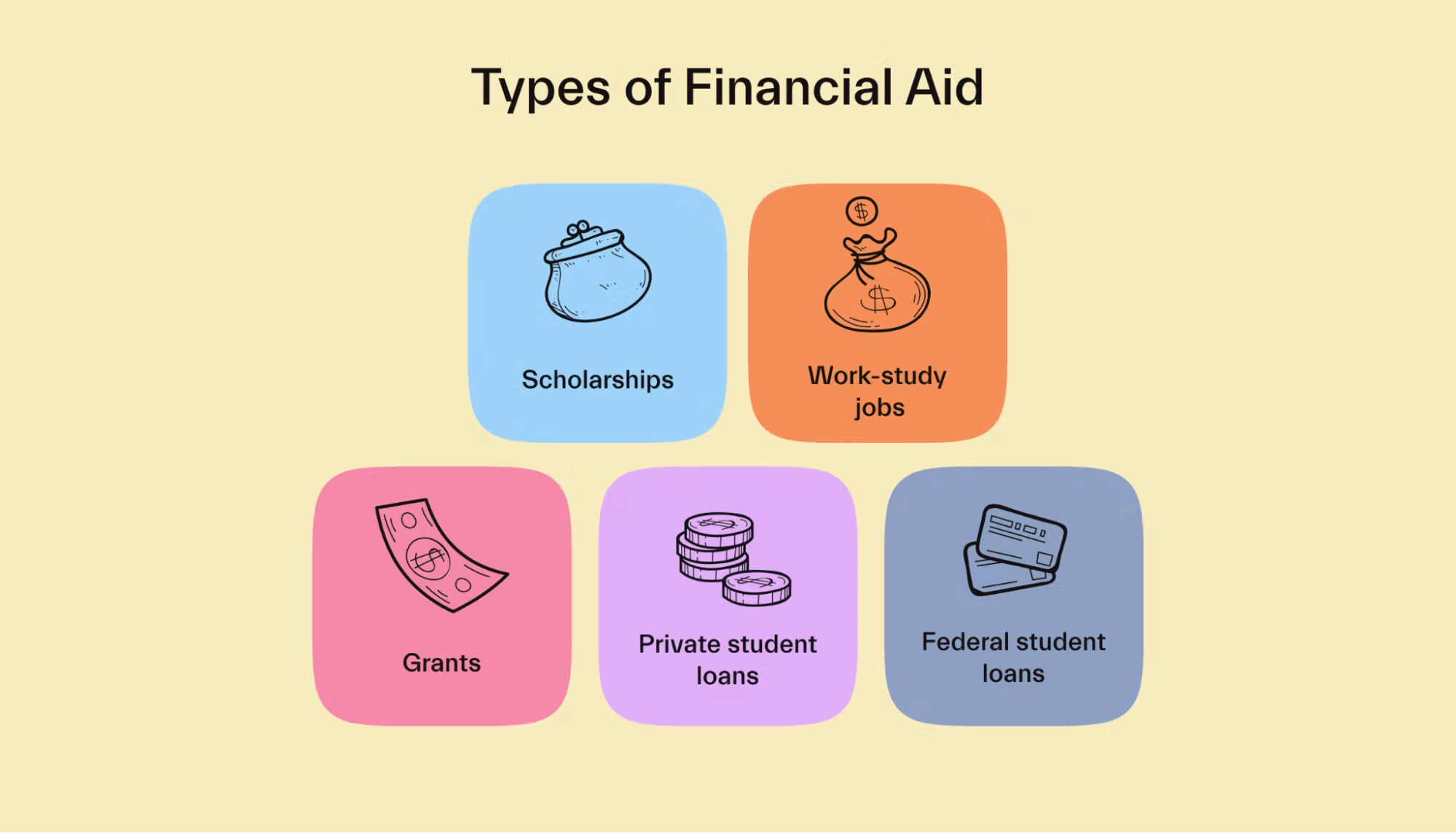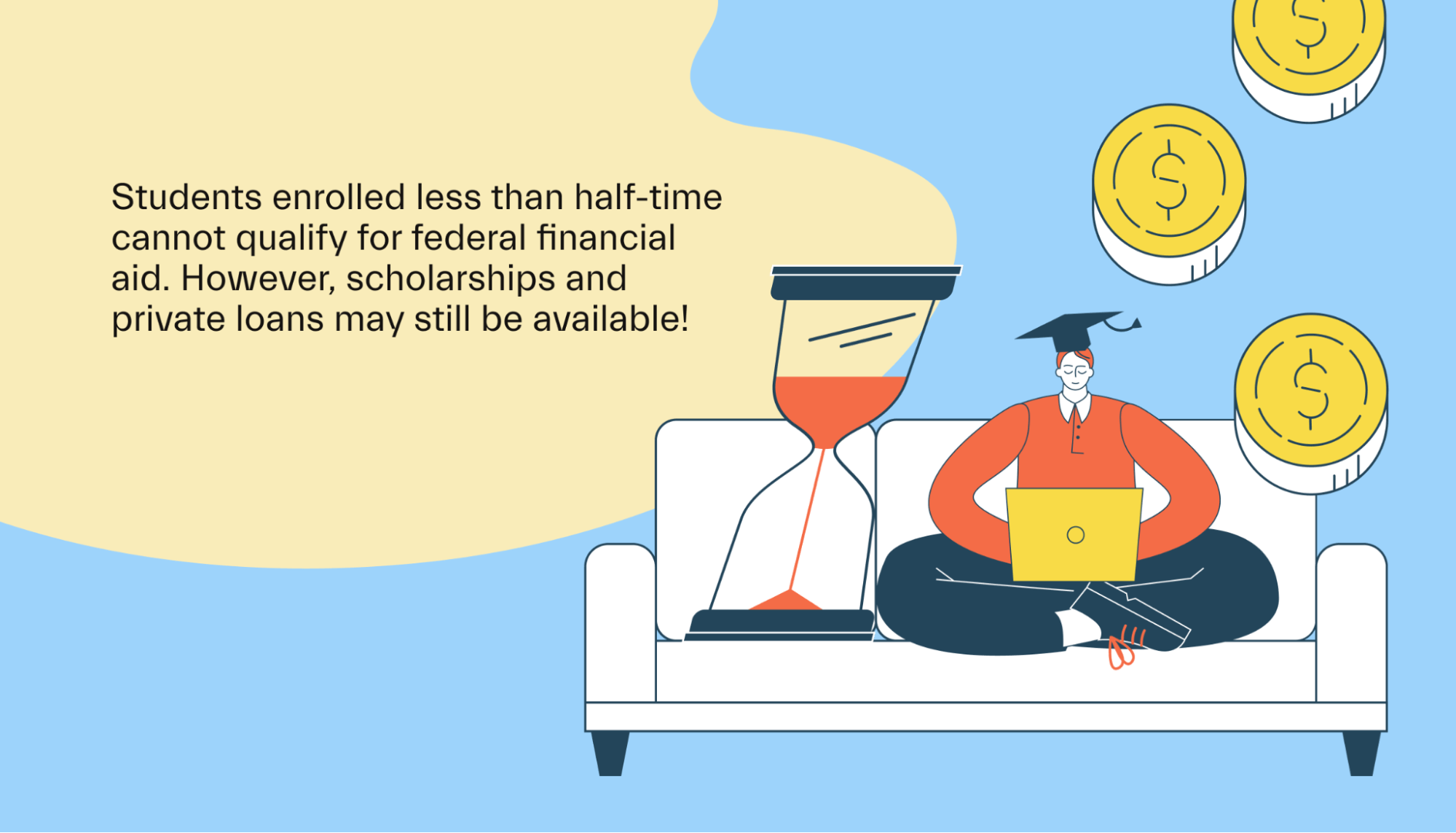Financial aid •
Your guide to financial aid as a part-time student
Are you a part-time student who wants to learn more about your financial aid options? This guide will tell you everything you need to know.

Most students apply for financial aid to help pay for school. Financial aid includes student loans, grants, and work-study.
With the increasing cost of college, most students rely on financial aid to help them manage. Most students enroll full-time, but many returning students enroll only half-time to help balance other life priorities.
So if you’re only enrolled in school part-time, can you still get financial aid?
This guide covers everything you need to know about part-time student financial aid, including how it works and where to get it.
Can part-time students get financial aid?
Yes, they can! Students can typically qualify for federal financial aid as long as they meet half-time enrollment qualification.

The specifics of half-time enrollment qualification can vary depending on the school. But it’s generally half of the expected full-time enrollment requirement.
For most schools, full-time enrollment is considered 12 or more credit hours per semester or quarter—usually around 4 classes per academic period.
So, half-time enrollment is typically 6 or more credit hours per semester or quarter—or around 2 classes per academic period.
To be safe, it’s best to check with the school(s) you may be attending to confirm what they consider to be half-time enrollment. Then, check with your school’s financial aid office for details. And if you’re applying to multiple schools, check with each one to make sure you qualify.
How does financial aid work for part-time students?
As long as the student is enrolled at least half-time, financial aid works the same as for a full-time student. The student fills out the necessary information for the FAFSA each year and then waits for their financial aid award letter.
As long as a student meets half-time enrollment requirements, they can apply for all the types of aid that a full-time student can qualify for. Of course, they’ll still need to meet some criteria, but they can apply as usual.

Keep in mind that financial aid is managed on a hybrid system. The federal government is closely involved, as they process the FAFSA and provide much of the funding for financial aid. But the schools generally handle the actual management and distribution of financial aid money.
Each college or university has a slightly different process for financial aid. These schools have dedicated financial aid departments to help students navigate this process. You should contact your school’s financial aid office if you have any questions.
The main types of financial aid are student loans, grants, work-study, and scholarships. Below, we’ll cover how part-time student financial aid works for each category.
Student loans
Student loans are loans for school that must be paid back eventually—with interest. There are 2 main types of student loans: federal and private.
Federal student loans: These are applied for via the Free Application for Federal Student Aid (FAFSA). They are available to most students and have competitive interest rates. Federal loans are available as long as the student meets half-time enrollment requirements.
Private student loans: These are applied directly from banks. They are available to well-qualified borrowers and may have higher interest rates than federal loans. Private lenders often require half-time enrollment as well, but this is up to the lender to decide.
When you hear people talking about student loans, they typically mean federal loans. These loans are the simplest to get and often the most affordable.
Federal student loans for part-time students work the same as they do with any other student. The student must submit the FAFSA; if qualified, they can choose to take out federal student loans. Most students are eligible for federal loans.
Grants
Grants are free money for school that doesn’t need to be paid back. The most common is the federal Pell Grant, available to qualified students who demonstrate a financial need.

Federal grants are applied for via the FAFSA. Part-time students can still qualify for grants; however, award amounts are proportional to students’ enrollment status.
For example, with the federal Pell Grant, a student enrolled half-time might receive half the award they’d have received if they were enrolled full-time. If a student is approved for a $5,000 Pell Grant, for instance, they may only receive $2,500 if they’re enrolled half-time.
Other grants can be available from state governments and organizations. These grants have several requirements, and some may require full-time enrollment.
Work-study
Work-study is a federal financial aid program that partially funds part-time jobs for students. This program makes it easier for students to find work while in school, allowing them to earn money through part-time (often on-campus) jobs.
Work-study is available for part-time students who meet half-time enrollment requirements. It might be a particularly good fit for these students, as they may have more time than full-time students to dedicate to working. Keep in mind, though, that work-study programs are limited to a maximum of 19 hours per week.
Scholarships
Scholarships are another form of free money for school that doesn’t need to be repaid. There are scholarships based on financial need, as well as merit scholarships, which are based on academic or athletic performance.
Most scholarships are applied for separately from the FAFSA. Most scholarships are available through schools, companies, private entities, and nonprofit organizations. To apply for scholarships, students usually need to go directly to the source offering the scholarship.
Each scholarship has its own qualification details. Some may be available to part-time students, but others may require full-time enrollment. Be sure to closely check the qualification requirements for any scholarships you’re considering.
How to access financial aid as a part-time student
For the most part, accessing financial aid while enrolled part-time is the same as it is for any other student. But there are a few unique aspects of it to keep in mind.
If you’re planning to go to school part-time, here’s how to navigate the financial aid process.
FAFSA for part-time students
Your first step will be to submit the Free Application for Federal Student Aid or the FAFSA. This application takes around an hour to complete (if you have all your information ready), and it must be submitted each academic year.

Filling out the FAFSA is how you qualify for all federal aid programs, including federal grants, federal student loans, and work-study.
To meet FAFSA requirements, students must be enrolled at least half-time (which usually means 6 or more credit hours per academic period).
All students should submit the FAFSA, and the process isn’t any different for part-time students than for full-time ones. For more info, read through these helpful tips for the FAFSA.
Private loan options
Most student loans are federal loans, which are applied for via the FAFSA. However, private student loans are also available.
Private loans work differently. They are applied for directly through the banks and financial institutions that offer them. And they often have stricter requirements—for instance, you typically need a good credit score and income to qualify.
Private lenders can make their own rules regarding who can apply for loans. For example, lenders will require that you are enrolled in a qualifying school—but they may or may not require enrollment in a certain number of credits.
Ask your existing bank or look for lenders online to apply for a private student loan. Then, follow their instructions to see if you qualify.
Scholarships
Scholarships are typically applied directly with the organization or company offering the scholarship. However, most applications can be submitted online.
Each scholarship has its own requirements. Some may be open to almost any student, while others have specific requirements. Many require an essay as part of the application.
Note that most scholarships require that the student has already submitted the FAFSA. The FAFSA won’t qualify you for most scholarships, but it’s the first step you should take before applying for any third-party scholarship opportunities.
For more information, read through our full guide on how to apply for scholarships.
Other grants
In addition to the federal grants you can apply for via the FAFSA, other grants may be available for some students.
These could include state-level grants, local/county-level grants, or even grants from private entities like nonprofits.
To get the most money for school, it’s wise to cast a wide net for any opportunities that you may qualify for.
What if I’m enrolled less than half-time?
If you’re enrolled less than half-time, you won’t qualify for federal financial aid programs. But you’re not totally out of luck—there are other ways to get help paying for school.

The main things to look into are private student loans and scholarships.
Private student loans: Lenders set their own requirements for enrollment status and other variables. While many lenders do require half-time enrollment, others don’t. If you shop around, you may be able to find a lender that’ll provide student loans for less than half-time enrollment.
Scholarships: Like private student loan lenders, scholarship providers set their own rules for who can apply for scholarships. Some don’t have minimum enrollment requirements. When looking for opportunities, read the fine print to see if you qualify.
Other loans: If you don’t qualify for aid but still want to attend school, your choices are either paying out of pocket or taking out additional loans to cover the cost. For example, you might choose to take out a personal loan—which can be used for any purpose—to pay for your classes. However, these loans often have higher interest rates, so this should be a last-resort option for aid.
Conclusion
Part-time students can still qualify for financial aid—you just need to be enrolled for at least a half-time class load. In most cases, this means at least 6 credit hours per semester.
As long as you meet the half-time requirements, applying for financial aid is the same as for any other student. Simply submit the FAFSA each year, and don’t forget to look for scholarships and other opportunities outside the FAFSA, too!
Want to learn more about getting financial aid as a part-time student? Check out Mos, the money app for students. Mos is a money app that helps students lower their tuition, match with top scholarships, and earn extra cash in college.
Let's get
your money
- Get paired with a financial aid expert
- Get more money for school
- Get more time to do you








